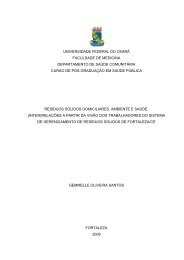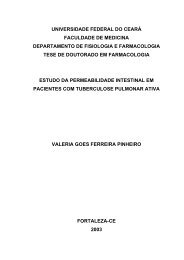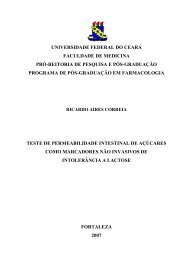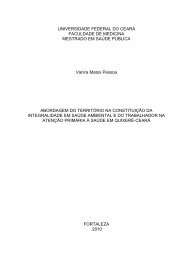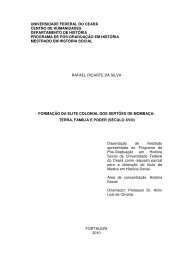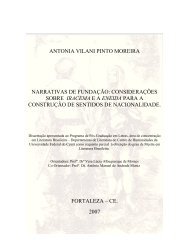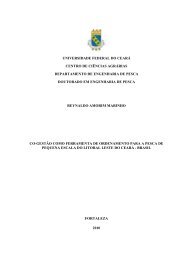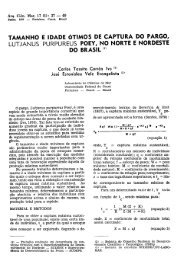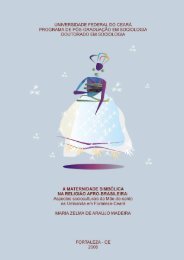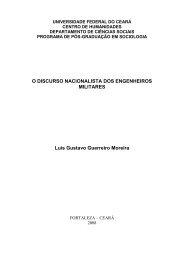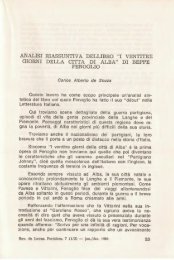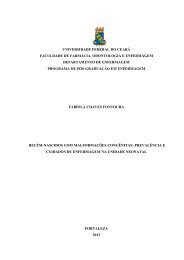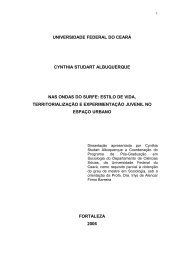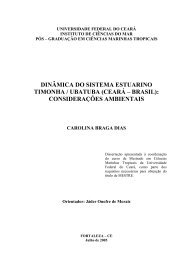Tungíase: doença negligenciada causando patologia grave
Tungíase: doença negligenciada causando patologia grave
Tungíase: doença negligenciada causando patologia grave
You also want an ePaper? Increase the reach of your titles
YUMPU automatically turns print PDFs into web optimized ePapers that Google loves.
Tropical Medicine and International Health volume 15 no 7 pp 856–864 july 2010<br />
L. Ariza et al. Rapid community assessment of tungiasis<br />
(a)<br />
60<br />
True prevalence (%)<br />
50<br />
40<br />
30<br />
20<br />
10<br />
(b)<br />
15<br />
True severe prevalence (%)<br />
12<br />
0 0 10 20 30 40 50<br />
9<br />
6<br />
3<br />
0 0<br />
y = 1.12x + 5.0<br />
R 2 = 0.96<br />
P < 0.0001<br />
Prevalence on periungueal sites of any foot (%)<br />
y = 0.24x – 3.4<br />
R 2 = 0.76<br />
P = 0.001<br />
10 20 30 40 50<br />
Prevalence on periungueal sites of any foot (%)<br />
Figure 3 Linear regression analysis for estimating prevalence of<br />
tungiasis (a) and of severe tungiasis (>20 lesions; b).<br />
Disease (Heukelbach et al. 2001; Franck et al. 2003;<br />
Heukelbach & Feldmeier 2004; Heukelbach &<br />
Ugbomoiko 2007b; Feldmeier & Heukelbach 2009). It<br />
occurs in many resource-poor communities in endemic<br />
countries and causes considerable morbidity and loss of<br />
quality of life, widely unnoticed by policy makers, the<br />
pharmaceutical industry and health professionals (Feldmeier<br />
et al. 2003; Heukelbach 2005; Joseph et al. 2006;<br />
Heukelbach & Ugbomoiko 2007b; Ugbomoiko et al.<br />
2007). Despite its obvious importance as a public health<br />
problem, data on disease occurrence in endemic communities<br />
and reliable data on the geographical distribution of<br />
tungiasis are not available. As a consequence, control of<br />
tungiasis has rarely been attempted (Heukelbach et al.<br />
2001; Pilger et al. 2008).<br />
Our data show that identification of tungiasis on<br />
periungual areas of the feet can be used to estimate<br />
prevalence of tungiasis and of severe disease in culturally<br />
and geographically distinct communities in South America<br />
and West Africa. The method is cheap, reliable and can be<br />
rapidly applied, with minimal disturbance of affected<br />
individuals. The assessment can be performed by para-<br />
medical workers or community members, as diagnosis of<br />
tungiasis can easily be performed by lay personnel living in<br />
endemic areas (Heukelbach 2005). In fact, in endemic<br />
areas, locals commonly affected by the disease diagnose<br />
tungiasis usually with a higher degree of certainty than<br />
health professionals (Heukelbach 2004).<br />
The method is an alternative to time-consuming and<br />
sophisticated analyses for the precise assessment of morbidity<br />
used in a previous study on tungiasis (Kehr et al.<br />
2007). As the number of lesions and morbidity are closely<br />
co-related (Kehr et al. 2007), the estimation of prevalence<br />
of individuals with more than 20 lesions indicates the<br />
occurrence of severe morbidity in a community. However,<br />
in our study, the strength of association was lower for the<br />
estimation of prevalence of severe tungiasis than for the<br />
overall prevalence. The rapid estimation method for severe<br />
tungiasis cannot be applied in the case of low prevalence of<br />
tungiasis at periungual sites, as in this case severe disease is<br />
rarely observed in a community.<br />
The delimitation of tungiasis-endemic areas based on<br />
valid data is essential to highlight the epidemiological<br />
situation in a country or region. It is also a prerequisite for<br />
disease control at the population level. Thus, the rapid<br />
epidemiologic assessment method proposed fills these gaps<br />
in endemic areas.<br />
In fact, rapid assessment tools were developed for the<br />
diagnosis of lymphatic filariasis with similar objectives: to<br />
determine the distribution of disease, identify high risk<br />
communities, and raise the attention of health policy<br />
makers (Gyapong et al. 1996, 1998a, b). As a result, about<br />
a decade later the ‘Global Programme to Eliminate<br />
Lymphatic Filariasis’ was implemented in collaboration<br />
with WHO. On the other hand, rapid assessment methods<br />
established for schistosomiasis and onchocerciasis were<br />
required to plan and monitor mass interventions programmes<br />
(WHO 1993, 1995; Red Urine Study Group<br />
1995). In general, all rapid approaches provide valid data<br />
quickly (Gyapong et al. 1996; Macintyre 1999). We<br />
believe that our rapid assessment method for tungiasis will<br />
be similarly helpful in launching, planning and monitoring<br />
community control measures against the disease.<br />
Rapid methods for other parasitic diseases, for example,<br />
for schistosomiasis, onchocerciasis and lymphatic filariasis,<br />
rely on the presence of indirect clinical or laboratory<br />
markers (Lengeler et al. 1991; Ngoumou et al. 1994;<br />
Gyapong et al. 1996; Kipp & Bamhuhiiga 2002; French<br />
et al. 2007; Weerasooriya et al. 2008; Ugbomoiko et al.<br />
2009). However, the objective of our study was not to use<br />
an indirect marker for prediction of disease in an individual.<br />
The proposed rapid assessment for tungiasis was based<br />
on direct identification of the parasite as diagnosis of<br />
tungiasis in an individual is easy to perform by clinical<br />
ª 2010 Blackwell Publishing Ltd 861



